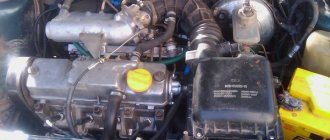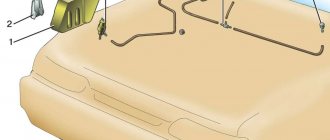Hello, dear friends! Many of those who operate a car have probably encountered a situation where water drips from the exhaust pipe.
At the same time, some immediately begin to panic, believing that such phenomena have serious causes. When starting the engine, the exhaust often steams during warm-up. Moreover, this should not be confused with smoke.
Most often, fumes and water from the exhaust system are clearly visible in winter or autumn, during wet and cold weather. Although it also occurs in summer. But is the formation of vapor clouds and liquid droplets escaping through the exhaust pipe of a vehicle really dangerous?! In reality, everything is not so scary.
The basis of this phenomenon is condensation. It is because of this that water sometimes literally pours, leaving behind a stain on the asphalt. Let's look at the reasons and what needs to be done in such situations.
Possible reasons
First, you need to find out exactly why water can appear and what exactly happens to the car.
Moreover, it doesn’t matter whether you bought a brand new Renault Captur or are using an old VAZ 2114. A characteristic sign in the form of dripping water, which often complements white smoke, is found on any car. That’s why owners of vehicles of various categories turn to forums with similar questions, ranging from old, sometimes even Soviet cars, to developments from leading auto companies, released almost a few months ago.
In most cases, motorists are faced with a simple physical phenomenon called condensation. Its formation is determined by the simplest laws of physics.
But there are cases when water and a large amount of steam indicate serious malfunctions, such as a broken head gasket or even a crack in the cylinder head.
Before thinking about how to remove water from the muffler, let's look at the reasons for its appearance.
All internal combustion engines heat up to very high temperatures during operation. Heat removal is ensured by the presence of a cooling system. In this case, the exhaust tract still remains heated. The intake pipes and exhaust manifold can warm up to 500-700 degrees Celsius, which is due to their location near the engine. And the pipes located a little further, like the muffler with the resonator, do not overheat as much. Although temperatures are still high.
When the engine stops, the steam that appears in the exhaust pipe begins to gradually settle on the inner walls. Steam, as you know, is one of the aggregate states of water.
It is these vapors that gradually turn into ordinary water. This is why, during a cold start, water often comes out of the exhaust, but when the engine is warm, everything goes away, since the high temperature promotes the complete evaporation of accumulated moisture.
How to prevent liquid from appearing in the exhaust pipe
Whether it’s a luxury car or an old car, this will not protect you from the laws of physics; condensation forms in all of them. The same applies to the quality of gasoline - there will be moisture in all brands, albeit in different volumes. But if water gets into the muffler, then effective recommendations should be followed. Tested by time and practice, they will help get rid of condensation:
- Store the car inside the garage when cold weather sets in. Many car owners prefer to leave their vehicles in the cold, not wanting to waste time walking from home to garage - in winter this is a gross disrespect for their car. If you park it in a warm room at night (for example, in a garage), then in the morning it will take less time to warm up.
- Auto warm-up This feature is available in most modern cars. It is important to set it up correctly so that the muffler warms up along with the car. Otherwise, there is no guarantee that even when this system is activated, the exhaust pipe will not be clogged with icy condensate. This applies to both cars with injectors and carburetors - however, the latter warm up more slowly.
- Pay attention to the parking spot. If the car is parked on a slope towards its muffler, then water flows out of it faster.
- Arrange at least weekly long trips. This is an effective prevention against the formation of an ice plug from frozen moisture.
- Insulate the exhaust pipe of a car if there is neither a garage nor a heating function. Non-flammable heat insulators or liquid heating are suitable for this.
- Change gas station. Poor quality fuel also contributes to the formation of condensation inside the muffler.
- Drill a tiny hole in the resonator. An old and controversial method that ensures the free flow of water. The disadvantage of this method is that this same hole will serve as a catalyst for the development of corrosion.
How to check the real mileage of a car: basic methods
This phenomenon is considered normal for the early spring and autumn-winter periods. Moreover, the most active accumulation of water in the exhaust system occurs precisely when the car is operated for short trips. The old moisture does not have time to evaporate, and at the same time new condensation appears. If you observe something similar that happens after the machine is brought to operating temperature, you should not worry at all. These are natural physical processes.
It’s another matter when, after heating, steam still appears in large volumes. There is no need to talk about black or blue smoke at all. This is a slightly different category.
The motorist should pay attention not only to the color of the liquid, but also to the nature of the smoke. I'll tell you more about this a little later.
And so, the engine has warmed up, but clouds of steam still come out of the pipe. Here you should pay attention to the following signs of a possible malfunction:
Why does a lot of water collect in the muffler?
Noticing condensation dripping from the exhaust pipe, an inexperienced car owner either panics or is perplexed. Rushing to the nearest service station is not the smartest idea. Several factors contribute to the accumulation of moisture in the inside of the pipe. You need to understand them in more detail:
When driving in winter
The cold season is the best condition for the formation of condensation in the muffler. The air temperature outside the exhaust pipe is much lower than inside it. So the moisture does not evaporate, but settles in a liquid state. Automatic warming up of the car partially solves the problem with condensation. But moisture still remains on the cold components of the exhaust system, because the idle speed is not so high as to blow it out with a stream of gases. Therefore, water settles inside the muffler, accumulating with each new heating.
How to properly make a U-turn from adjacent territory
- Coolant is boiling in the expansion tank. Not the best sign, the reasons for which vary;
- In the same expansion tank, the fluid level drops. Moreover, after adding coolant, it disappears again in a short period of time;
- If you over-gas, a thick cloud of steam comes out of the exhaust, which is accompanied by drops of moisture;
- The temperature sensor is triggered and reports overheating of the power plant.
An unpleasant situation that often requires disassembling the cylinder block and removing its head. It's hard not to notice a broken gasket.
In addition to violating the integrity of the cylinder head gasket, deformation of the contact surface between the block and its head cannot be ruled out.
How to reduce the amount of moisture or steam when warming up
It is completely impossible to get rid of water that gets into the muffler, but you can reduce its amount if you perform a number of the following actions:
- make not only short, but also long trips by car;
- before turning off the already well-warmed engine, do a long release of gas;
- To allow condensate to escape, you can make a small hole in the muffler (resonator).
By the way, holes for draining condensate in mufflers on some vehicles are provided by the manufacturer. This solution allows you to increase the service life of exhaust system parts.
The problem is solved by making a hole in the muffler. Before carrying out work, the car is placed on a pit or raised using a lift. Required materials and tools: drill and drill bits from 1.5mm to 2mm.
Carrying out the work in stages:
- Having found the rear “can” of the muffler, make a hole at the lowest point with a drill;
- As soon as liquid begins to flow out, immediately remove the power tool to the side;
- if necessary, make another hole from the bottom on the other side of the can.
This method is simple, but it is important to take into account possible freezing of the holes in winter. Also, in the place where the holes are drilled, corrosion can actively corrode the metal. In any case, if condensation from the exhaust pipe is a problem, drilling holes can help reduce the intensity of the moisture buildup.
Note the smoke and color of the liquid
We have already found out that with a cold engine while the engine is warming up, there is nothing wrong with the appearance of water and white smoke. This is just steam, which will soon evaporate completely and stop dripping from the pipe.
But it happens that the character of the smoke is completely different, dark or bluish in color. At the same time, not just water flows out, but some kind of black liquid. Sometimes motorists note that the color of the water is yellow.
It is worth considering all these situations and possible reasons for their occurrence.
Drive types
Since balancing shafts are designed to balance the crankshaft, their operation must be synchronized with this part of the unit. For this reason, they are connected to the timing drive.
To dampen rotational vibrations, the drive gear of the balancer shafts has springs. They allow the drive to rotate slightly around its axis, ensuring a smooth start to movement of the device.
Most often, a common drive belt or chain is used, mounted on the motor. Gear type drives are much less common. There are also combined modifications. In them, the shafts are driven by both a toothed belt and a gearbox.
Installing gas equipment on a car: how to do it legally
- Blue smoke and dark liquid color. If the clouds of smoke are thick and characterized by this color, then the elements of the cylinder-piston group have probably worn out and the piston rings have become stuck. You urgently need to contact an experienced mechanic;
- The smoke is black and the liquid is of a similar color. Here you will have to check the condition of the fuel system. Excessive consumption of fuel occurs, fuel is mixed with oil due to a violation of the integrity of connections, gaskets, etc.;
- Gray but weak smoke is most often associated with hardened valve stem seals. They will have to be changed. If you have a turbo engine, then it is possible that the turbocharger itself may break down.;
- Yellow color of water. The situation here is ambiguous. Many motorists claim that the yellow color is due to the coloring of fuel at some gas stations. This is quite consistent with reality, so this option should not be ruled out. Or the exhaust system has rusted from the inside, that is, yellow water is a banal consequence of rust formation.
There is nothing good about black smoke. In the vast majority of cases, fuel burns poorly or incorrectly. The reasons themselves may lie in pinched valves, clogged injectors, a broken carburetor, a clogged air filter, a broken high-pressure pump, etc.
Condensation in the muffler and other problems
Many motorists are faced with the problem of condensation in the exhaust pipe and, as a result, water droplets appearing in the muffler. Sometimes this is a normal phenomenon, but it happens that condensation in the muffler is a kind of alarm beacon indicating a malfunction of the internal systems of the car.
Where does water come from?
The main problem with condensation is invisibility. Most of us simply do not pay attention to its appearance until the amount of liquid becomes noticeable to the naked eye. In winter, when water constantly changes from one state to another, this is a particularly dangerous phenomenon. But in the summer, liquid dripping from the exhaust also does not bode well.
Condensate itself is basically water, which is formed during the transition from a gaseous state to a liquid state. In nature, it is constantly formed, but does not cause damage. But it can become a problem for a car. It can form not only in the muffler, but also in the internal systems of the car: fuel, oil, and also in the cooling system. It also accumulates in the cabin and closed areas of the body. In any case, there is harm from this. But its degree differs in each individual case.
The moment you turn off the engine, condensation begins to form in the exhaust pipe. Even if the car is new and fully working. This is a natural phenomenon from which it is impossible to protect yourself. The outside of the entire system cools much faster than the inside. Small accumulations of moisture appear in the muffler, which freeze in a short time and cover the “insides” with an ice crust. Experts say that this phenomenon does not cause much harm in this case, but many drivers are wary of it.
The fact is that a small accumulation of moisture in the muffler during active use of the car may, on the contrary, indicate its serviceability and proper operation. Here are some examples of how and why condensation occurs:
Conclusion: if in winter at sub-zero temperatures water drips from the muffler, and the amount is small, this is not a reason to panic and not a reason to go to the nearest service station to carry out thorough diagnostics and repairs.
What dangers does condensation pose?
Once formed in the muffler, it will cause virtually no harm. Although over time it becomes the main cause of corrosion. But in winter, the corrosion process occurs much more slowly than in the warm season. If in winter the car is not warmed up at least once a day, the amount of frozen condensate in the exhaust may increase to such a level that the car simply will not start after a couple of days of inactivity. To avoid such troubles, some advise drilling a small hole in the resonator to allow unnecessary moisture to drain. However, this solution is not the best. The problem is that the metal around the hole you make will corrode much faster. As a result, after a short amount of time you will have to completely change the exhaust pipe. Agree, if such a method were effective, manufacturers themselves would use it at the manufacturing stage.
Engine overhaul: when is it necessary?
If you are concerned about the presence of water droplets and white smoke (steam), but there are no other signs of engine problems, there is no need to worry. If desired, you can follow a few simple rules so that condensation occurs in a smaller volume.
To reduce steam output you can:
- periodically travel not only short distances, but also carry out long trips;
- make a hole in the resonator through which condensate will escape;
- Give it a good throttle when the engine is warm, then turn it off.
By the way, on some cars a drain hole is provided from the factory. There is no need to drill anything additional here.
And I’ll say a few more words regarding the freezing of water in the exhaust system. If ice forms in narrow passages, then the exhaust removal process will be disrupted, the engine will no longer start normally or will stall.
Symptoms of a catalyst asking for scrap
The original exhaust system component has a service life equal to the life of the vehicle. But, as you know, there are exceptions to everything. It often fails prematurely, taking the engine with it. In most cases, the catalytic converter breaks down due to improper functionality of the ignition system. Also, incomplete combustion of the mixture in the cylinders can cause its malfunction. Poor quality fuel is also among the reasons.
Characteristic signs indicating a breakdown of the catalyst:
Engine performance drops sharply.
This is the most common manifestation when there is a loss of car dynamics and poor acceleration. The motor may not work stably or may stall. Such symptoms are especially noticeable when the throughput decreases. Which is characterized by the destruction of honeycombs, melting, and blockage of holes. As a result, the free passage of exhaust gases is closed.
The malfunction first appears when accelerating to a low speed, after which the running engine struggles, gasps and may stall completely. Noticeable deterioration is also evident in fuel economy. There are unpleasant odors during a cold start.
Loud noises under the car.
If you hear an incredible roar coming from under the bottom of the car, this indicates the destruction of the catalyst, its disintegration into pieces. Due to the fact that the ceramic parts randomly hit the surface of the casing under the force of the exhaust, strong knocks are obtained. This is usually clearly audible at increased engine speeds, and also when starting it.
Weak exhaust output from the muffler.
Placing your palm to the exhaust pipe, you can feel the vibration of the exhaust cylinder valves, which pulsate in turn. When the exhaust flow is smooth and constant at idle, the catalyst is one hundred percent clogged. You can increase the speed and then stop the engine; the exhaust gases will create pressure for some time, releasing the gases accumulated inside the pipe.
A clear breakdown of the catalyst will be a system error on the instrument panel. Using a diagnostic scanner, you should read the code for such a problem. It happens that the “brain” of the car detects incorrect values on the oxygen sensors, informing the driver about this. At the same time, the engine control system is switched to emergency mode. Which leads to deterioration in dynamics and increased fuel consumption.










